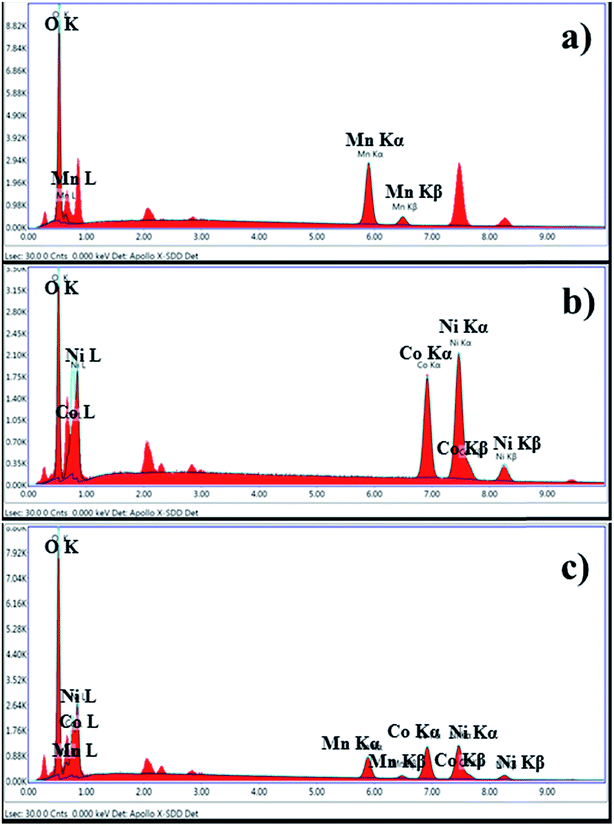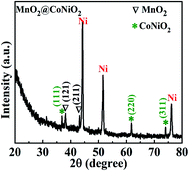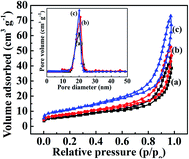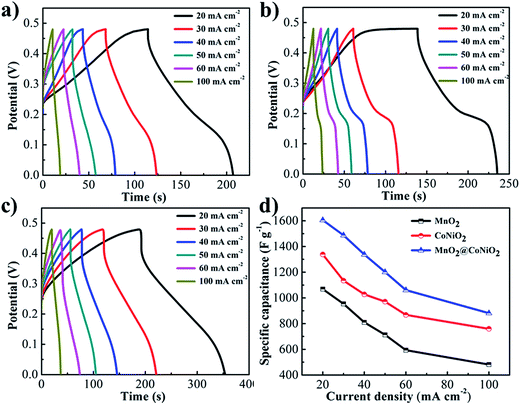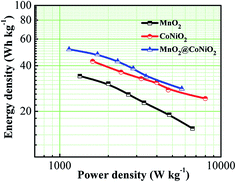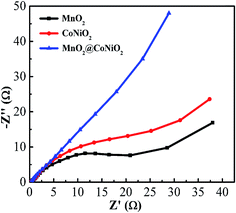 Open Access Article
Open Access ArticleCreative Commons Attribution 3.0 Unported Licence
Fabrication of a snail shell-like structured MnO2@CoNiO2 composite electrode for high performance supercapacitors
Araveeti Eswar Reddy,
Tarugu Anitha,
Chandu V. V. M. Gopi,
S. Srinivasa Rao ,
Chebrolu Venkata Thulasi-Varma,
Dinah Punnoose and
Hee-Je Kim
,
Chebrolu Venkata Thulasi-Varma,
Dinah Punnoose and
Hee-Je Kim *
*
School of Electrical Engineering, Pusan National University, Busandaehak-ro 63beon-gil, Geumjeong-gu, Busan 46241, South Korea. E-mail: heeje@pusan.ac.kr; Fax: +82 51 513 0212; Tel: +82 51 510 2364
First published on 21st February 2017
Abstract
For the first time, we develop a cost-effective and facile one-step hydrothermal approach to directly grow MnO2@CoNiO2 snail shell-like, CoNiO2 nanoflake-like, and MnO2 nanoflower-like structures on nickel foam as electrode for supercapacitor applications. Cyclic voltammetry, galvanostatic charge–discharge cycling, and electrochemical impedance spectroscopy are used to investigate the electrochemical responses of the electrodes. The MnO2@CoNiO2 composite electrode exhibits a high specific capacitance and energy density of 1605.4 F g−1 and 51.37 W h kg−1, respectively, at 20 mA cm−2 in 3 M KOH aqueous solution, as well as an attractive cycling ability (98.87% even after 3000 cycles at 40 mA cm−2), which are much better than those of the CoNiO2 and MnO2 electrodes. Such superior electrochemical performance of the MnO2@CoNiO2 electrode is attributed to the combination of two active materials with an improved surface morphology, which can offer more pathways for electron transport and enhance the utilization of the electrode materials. These results show that the MnO2@CoNiO2 composites are promising positive electrode materials for practical supercapacitors.
1. Introduction
Lightweight, high performance, excellent reversibility, stability, safety, and environmentally friendly energy storage devices, such as supercapacitors (SCs) and lithium-ion batteries, are required in the present modern electronic industry.1,2 Lithium-ion batteries (LIBS) and supercapacitors (SCs) have attracted considerable worldwide attention. SCs, also called ultra-capacitors or electrochemical capacitors (ECs), are considered as a new class of electrochemical energy storage devices because they can achieve higher energy density and power density when compared to traditional capacitors and batteries.3–8 Supercapacitors (SCs) have attracted increasing attention due to their simple principle, fast recharge ability, long cycle life, high power performance, and low maintenance cost,9,10 which allows applications for a range of power and energy necessities, such as short-term power sources for mobile electronic devices, hybrid electric vehicles, etc.11,12SCs can be classified into two categories, pseudo capacitors and electrical double-layer capacitors (EDLCs), according to the electrochemical storage mechanism. Typically, pseudo capacitors have a much larger energy density and higher specific capacitance than EDLCs due to the reversible faradaic redox reactions at the electrode surface.13–15 Many different materials and its systems have been studied widely as active electrode materials for SCs because of their higher theoretical specific capacitance.16–18 Transition metal oxides/hydroxides, carbonaceous materials, and conducting polymers are commonly used materials for supercapacitor applications.19–26 Among them, transition metal oxides usually offer good electrical performance because of their increased conductivity and their synergic effects.27,28 Transition metal oxides, such as RuO2, V2O5, NiO, MoO3, NiCo2O4, Co3O4, TiO2, SnO2, and MnO2,27–40 have been studied as an attractive electrode material for SCs. Moreover, the electrochemical performance, natural abundance, low cost, and environmental friendliness of MnO2 makes it a promising candidate for supercapacitor electrodes.41–44 Recently, many literatures about the fabrication and its super capacitive behavior of NiCo2O4 have been investigated, such as nanoflakes, nanoparticles, nanowires and flowers.45–48 The use of both metals in this way enhances electronic conductivity with a reduction in the ternary metal oxides, and is beneficial to electrochemical applications.49 However, there have been very few studies on the synthesis and supercapacitor evaluation of CoNiO2 due to the lack of feasible fabrication methods without the use of poisonous and noxious reagents to realize mass production.50,51 Therefore, simple and scalable preparation routes for MnO2 and CoNiO2 should be investigated to achieve various structure designs of MnO2 and CoNiO2 nanomaterials with different morphologies for practical applications and supercapacitor performance is unsatisfactory.52,53 Therefore composites were developed to improve the electrochemical performance of supercapacitors.
Currently, composites containing oxides have been studied most widely. First-rate supercapacitor electrode materials, such as CNT@MnO2, CuO@MnO2, Co3O4/SnO2@MnO2, TiO2@MnO2, ZnCo2O4@Ni, ZnO@Ni3S2, ZnO@MnCo2O4, Fe3O4@Fe2O3, Co3O4@MnO2, Fe3O4@MnO2, and ZnCoO4@MnO2,54–64 have attracted considerable attention. Recently, Yu et al. developed NiCo2O4@MnO2 integrated electrode for high-performance supercapacitors.65 Impressively, the Ni foam-supported core–shell heterostructured NW array electrode (NiCo2O4@MnO2) delivers higher area specific capacitance of 3.31 F cm−2 at current density of 2 mA cm−2. On the other hand, there are no reports on the electrochemical capacitance of their integrated materials with the aim of elevating the supercapacitor performance by rationally combining CoNiO2 and MnO2, even though the individual capacitive behavior of both has been demonstrated.
In this study, a low cost and facile strategy was developed for the design and fabrication of novel hierarchical MnO2@CoNiO2 nanotube arrays on nickel foam using a facile hydrothermal pathway for supercapacitor applications. This hybrid nanotube arrays delivered a high specific capacitance of 1605.4 F g−1, and operated at a high power density of 1142.75 W kg−1 with an energy density of 51.37 W h kg−1 at a current density of 20 mA cm−2. These interesting results highlights the potential of MnO2@CoNiO2 supercapacitors as a high performance energy storage system for practical applications.
2. Experimental section
2.1 Materials
All chemicals, such as manganese(II) nitrate tetrahydrate [Mn(NO3)2·4H2O], cobalt(II) nitrate hexahydrate [Co(NO3)2·6H2O], nickel(II) sulfate hexahydrate [NiSO4·6H2O], ammonium fluoride [NH4F], urea [CH4N2O], potassium hydroxide [KOH], and nickel (Ni) foam were purchased from Sigma-Aldrich and used as received.2.2 Synthesis of MnO2, CoNiO2 and MnO2@CoNiO2 electrodes
In a typical procedure, a piece of Ni foam was cut into 1 × 1 cm2 squares and cleaned ultrasonically in a 2 M HCl solution for 30 minutes. The Ni foams were then cleaned sequentially in acetone, ethanol, and DI water for 15 min each. For the synthesis of the MnO2@CoNiO2 electrode, 0.702 g (0.04 M) of Mn(NO3)2·4H2O, 0.814 g (0.04 M) of Co(NO3)2·6H2O, and 0.735 g (0.04 M) of NiSO4·6H2O were dispersed in 70 ml of DI water and stirred vigorously for 30 min to form a homogeneous solution. Subsequently, 0.622 g (0.24 M) of NH4F and 2.018 g (0.48 M) of CH4N2O were added sequentially to the above homogeneous solution. After stirring for 30 minutes, the solution was poured into a 100 ml polytetrafluoroethylene (PTFE) Teflon-lined stainless steel autoclave and the pretreated Ni foam was dipped into the reaction mixture. The autoclave was sealed and maintained at 100 °C for 6 h, and cooled naturally to 27 °C. The as-gained Ni foam was removed, washed with DI water, and dried in the oven. Finally, MnO2@CoNiO2 electrode was obtained by annealing the sample at 200 °C for 2 h in air. CoNiO2 and MnO2 electrodes were also prepared using the above procedure with the relevant chemicals. The loading of the MnO2@CoNiO2, CoNiO2, and MnO2 samples was approximately 4.2, 3.6, and 3.0 mg cm−2, respectively.2.3 Materials characterization
The morphology of the films was analyzed by field emission scanning electron microscopy (FE-SEM, S-2400, Hitachi) equipped with energy-dispersive X-ray spectroscopy (EDX) operated at 15 kV. The crystalline nature and structure of the electrodes were studied by X-ray diffraction (XRD) analysis on a D8 ADVANCE with a diffractometer using a Cu Kα radiation source operated at 40 kV and 40 mA in the 2θ range of 20–80°. X-ray photon electron spectroscopy (XPS, VG Scientific ESCALAB 250) was performed using monochromatic Al-Kα radiation at 1486.6 eV. Brunauer–Emmett–Teller (BET) analysis was used to measure the specific surface area of the samples using a BELsorp-Max (BEL, Japan) instrument at 77 K.2.4 Electrochemical measurements
All electrochemical characterizations were conducted in a three-electrode configuration consisting of MnO2 (or CoNiO2 or MnO2@CoNiO2), Pt wire, and Ag/AgCl as the working electrode, counter electrode, and reference electrode, respectively. The supporting electrolyte consisted of a 3 M KOH aqueous solution. Cyclic voltammetry (CV), galvanostatic charge–discharge tests, and electrochemical impedance spectroscopy (EIS) were measured using a Biologic-SP150 workstation. CV was studied at a potential range from +0.0 V to +0.5 V at 5 mV s−1 to 100 mV s−1 scan rates. The galvanostatic charge–discharge tests were studied by chronopotentiometry at a voltage window of +0.0 V to +0.48 V at different current densities (20–100) mA cm−2. Electrochemical impedance spectroscopy (EIS) was conducted over a frequency region from 0.1 Hz to 500 kHz. The specific capacitance (Cs, F g−1), energy density (E, W h kg−1), and power density (P, W kg−1) were calculated from the galvanostatic charge–discharge curves using the following equations:66,67
 | (1) |
 | (2) |
 | (3) |
3. Results and discussion
The morphology and composition of the precursor samples were analyzed by low and high magnification FE-SEM. Fig. 1 presents the morphology of the MnO2, CoNiO2, and MnO2@CoNiO2 on the Ni-foam substrates. Fig. 1(a1 and a2) show FE-SEM images of the MnO2 electrode, which had a nanoflower morphology with a uniform deposition. Fig. 1(b1 and b2) present low and high magnification SEM images of the as-synthesized nanoflakes, such as the CoNiO2 sample. A low magnification FE-SEM of MnO2@CoNiO2 (Fig. 1(c1)) revealed uniform snail shell-like structure deposited on the Ni-foam. On the other hand, the high magnification FESEM image of MnO2@CoNiO2 (Fig. 1(c2)) showed the dense CoNiO2 nanoneedles attached to the MnO2. These novel nanostructured films provided an abundant porous surface area for contact between the electrolyte and electrode, which enhanced the performance of supercapacitors.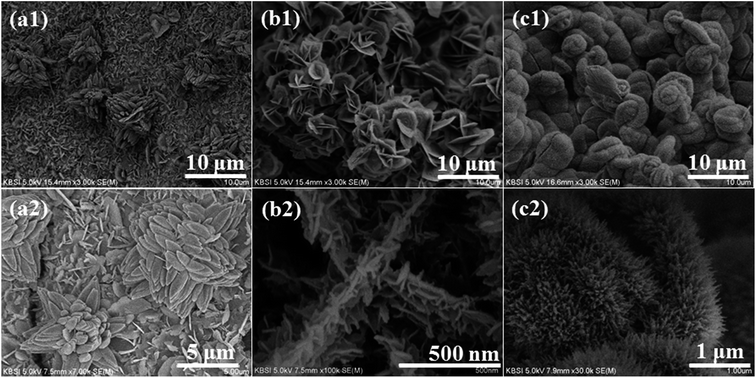 | ||
| Fig. 1 (a1, b1 and c1) high magnification and (a2, b2 and c2) low magnification typical FE-SEM images of the (a1 and a2) MnO2, (b1 and b2) CoNiO2 and (c1 and c2) MnO2@CoNiO2 electrodes. | ||
EDX was performed to determine the elemental distribution of the prepared electrodes. Fig. 2a–c present the EDX spectra of MnO2, CoNiO2 and MnO2@CoNiO2 electrodes, respectively. The EDX spectrum of MnO2 revealed Mn and O, whereas CoNiO2 exhibited Co, Ni, and O. On the other hand, the EDX spectrum of MnO2@CoNiO2 contained Co, Ni, Mn, and O, confirming that the MnO2@CoNiO2 had been deposited successfully on the surface of the Ni-foam. The crystal structures of the MnO2@CoNiO2 precursor was further studied using XRD analysis, as shown in Fig. 3. Besides the three strong peaks from the nickel foam substrate, the other diffraction peaks can be indexed to the (121) and (211) planes of the MnO2 (JCPDS no. 14-0644) and the (111), (220) and (311) planes of the CoNiO2 (JCPDS no. 10-0188), which is consistent with the previous literatures.68,69
XPS is one of the most useful and effective techniques for analyzing the surface composition and oxidation states of the elements. Fig. 4a presents the survey spectrum of the MnO2@CoNiO2 composite, indicating the existence of Co, Ni, O, C, and Mn. The high-resolution Co 2p spectrum (Fig. 4b) exhibited peaks at 781.8 eV and 797.15 eV for Co 2p3/2 and Co 2p1/2, respectively.70 These two oxidation states were separated by a 15.35 eV spin energy, which indicates Co+2. The Ni 2p spectrum (Fig. 4c), showed two main spin–orbit peaks of Ni 2p3/2 at 856.24 eV and Ni 2p1/2 at 873.31 eV with a separation of approximately 17 eV, which is characteristic of Ni2+.71 The high resolution scan of Mn 2p of the composite (Fig. 4d) showed two peaks at 642.48 and 653.32 eV, which were assigned to Mn 2p3/2 and Mn 2p1/2, respectively, and the binding energy peaks of Mn 2p were separated by 10.84 eV. XPS confirmed that the MnO2@CoNiO2 composite consisted of Co2+, Ni2+, and Mn2+.
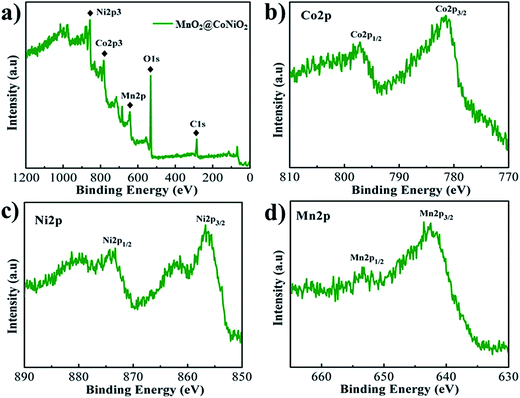 | ||
| Fig. 4 XPS spectrum of MnO2@CoNiO2 on Ni-foam; (a) survey spectrum, high-resolution spectra for (b) Co 2p, (c) Ni 2p, and (d) Mn 2p. | ||
To investigate the specific areas and the porous nature of the MnO2, CoNiO2 and MnO2@CoNiO2, BET gas sorption measurements were performed. The nitrogen adsorption/desorption isotherms and the pore size distribution plots of the three samples are shown in Fig. 5. Type IV isotherms were clearly exhibited, denoting the existence of mesopores in the three samples. The BET surface area of the prepared MnO2@CoNiO2 composite was obtained to be 40.6 m2 g−1, which was higher than that of the CoNiO2 (27.3 m2 g−1) and MnO2 (22.6 m2 g−1) samples. The pore size distribution curves from the N2 adsorption isotherm of the Fe-SNC and SNC are shown in the inset of Fig. 5, it can be seen that MnO2@CoNiO2 has the pore size distribution of 20.1 nm, whereas MnO2 and CoNiO2 show pore sizes of 20.4 and 20.8 nm. These results indicate that the three samples are having mesoporous structures with large surface area that is much needed for the electro-catalytic applications.
CV was conducted in a 3 M KOH electrolyte over the potential range, 0.00 to 0.50 V at different scan rates of 5 to 100 mV s−1 for the MnO2, CoNiO2 and MnO2@CoNiO2 electrode materials, as shown in Fig. 6. Fig. 6a shows the CV curves of the three electrodes at a scan rate of 20 mV s−1 in a 3 M KOH electrolyte solution. The CV curve shape is different from the electric double-layer capacitance, showing that the capacitance was due mainly to the pseudo capacitive capacitance. Moreover, from the CV curve shapes, the integrated area of the MnO2@CoNiO2 electrode was higher than that of the other two electrode materials, showing that the MnO2@CoNiO2 electrode has the largest specific capacitance compared to the CoNiO2 and MnO2 electrodes. Fig. 6b and c shows a smaller surrounded area of CoNiO2 and MnO2 than that of the MnO2@CoNiO2 (Fig. 6d), suggesting the low electrochemical performance of CoNiO2 and MnO2.
Furthermore, the electrochemical performance of the electrodes was examined by galvanostatic charge–discharge (GCD) tests. The GCD measurements were studied over the potential range, +0.0 V to +0.48 V, at different current densities (20 to 100 mA cm−2). Fig. 7a–c show GCD plots of the MnO2, CoNiO2, and MnO2@CoNiO2 electrodes, respectively. The extracted specific capacitance of MnO2@CoNiO2 (Fig. 7d) were 1605.4, 1487.7, 1338.2, 1201.3, 1060.7, and 881.4 F g−1 at current densities of 20, 30, 40, 50, 60, and 100 mA cm−2, respectively. The measured specific capacitances of CoNiO2 were 1338.4, 1134.4, 1028.1, 970.8, 867.9, and 759.7 F g−1 at different current densities. Those of MnO2 were 1069.0, 953.8, 810.1, 713.5, 593.7, and 482.0 F g−1 at different current densities. The specific capacitance increased gradually with decreasing current density. The MnO2@CoNiO2 electrode showed a high specific capacitance of 1605.4 F g−1 at a current density of 20 mA cm−2, whereas that of the CoNiO2 and MnO2 electrodes were only 1338.4 and 1069.0 F g−1 at the same current density. The excellent and superior specific capacitance of MnO2@CoNiO2 may be due to its higher surface area with the improved morphology of nanostructures. The power density and energy density are two essential parameters to examine the performance of supercapacitors. Fig. 8 shows the Ragone plots of MnO2, CoNiO2, and MnO2@CoNiO2. The MnO2@CoNiO2 exhibited a high energy density (51.37 W h kg−1) and power density (1142.75 W kg−1), which were much higher than those of the CoNiO2 (42.83 W h kg−1 and 1599.95 W kg−1) and MnO2 (34.21 W h kg−1 and 1333.29 W kg−1) at a current density of 20 mA cm−2.
EIS is an efficient way to examine the electrochemical properties of electrodes; the impedance was measured over the frequency range, 100 mHz to 500 kHz, at a bias of 0 V, and the plots are shown in Fig. 9. All plots displayed a depressed semicircle in the high-frequency region and a straight line in the low-frequency region. At high frequencies, the Z′-axis intercept indicated the equivalent series resistance (ESR) and the semicircle diameter was assigned to the charge transfer resistance (Rct) at the interface of electrode/electrolyte. The ESR value of the MnO2@CoNiO2 electrode was smaller than that of the other two electrodes (MnO2, CoNiO2), which reflects the higher conductivity obtained in the MnO2@CoNiO2 electrode. On the other hand, as shown in the figure, a significant change in Rct was observed after MnO2@CoNiO2 was added to the electrode material. According to the diameter of the semicircle, the Rct of MnO2, CoNiO2, and MnO2@CoNiO2 electrodes were 27.3 Ω, 25.1 Ω, and 3.8 Ω, respectively, which shows that the MnO2@CoNiO2 composite can enhance the electronic conductivity and develop electron transfer at the interface of electrode material compared to MnO2 and CoNiO2 electrodes. The low ESR and Rct of the MnO2@CoNiO2 electrode plays an important role in improving the performance of supercapacitors.
The stability of the electrode materials is one of the most important requirements for supercapacitor applications. The cycling stability test of the MnO2, CoNiO2, and MnO2@CoNiO2 electrodes were evaluated at a constant charge–discharge current density of 40 mA cm−2 for 3000 cycles, as shown in Fig. 10. The MnO2 electrode for the 1st cycle showed a specific capacitance of 800.32 F g−1, which decreased slowly to 762.36 F g−1 after 3000 cycles, showing 4.94% loss after 3000 cycles. The CoNiO2 electrode showed specific capacitances of 1021.45 F g−1 and 998.56 F g−1 at the 1st cycle and after 3000 cycles, respectively, showing 2.30% loss after 3000 cycles. On the other hand, the MnO2@CoNiO2 electrode exhibited only 1.13% loss of a specific capacitance after more than 3000 cycles, highlighting the good long-term stability of the MnO2@CoNiO2 electrode.
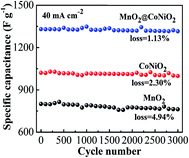 | ||
| Fig. 10 Cyclic performance of the MnO2, CoNiO2 and MnO2@CoNiO2 electrodes at a current density of 40 mA cm−2 for 3000 cycles. | ||
4. Conclusions
In summary, novel MnO2@CoNiO2 snail shell-like structures were designed and synthesized using a simple hydrothermal method followed by annealing. The MnO2@CoNiO2 composite electrode exhibited superior specific capacitance (1605.4 F g−1) and energy density (51.37 W h kg−1), which were much higher than those of the MnO2 (1069.0 F g−1; 34.21 W h kg−1) and CoNiO2 (1338.4 F g−1; 42.83 W h kg−1) electrodes at a current density of 20 mA cm−2. The elevated performance of the composite electrode was attributed to the improved surface morphology with a high surface area, which facilitates electron diffusion at the contact between the electrode and electrolyte. Moreover, the MnO2@CoNiO2 electrode delivered outstanding cycling stability with a capacity retention of 98.87% after 3000 cycles (97.7% and 95.06% for the CoNiO2 and MnO2 electrodes after 3000 cycles, respectively). As a result, the MnO2@CoNiO2 composite electrode provides a path for high-performance supercapacitors because of its low-cost, facile preparation, and environmental friendliness.Acknowledgements
This research was supported by Basic Research Laboratory through the National Research Foundations of Korea funded by the Ministry of Science, ICT and Future Planning (NRF-2015R1A4A1041584).References
- B. Liu, D. Tan, X. Wang, D. Chen and G. Shen, Small, 2013, 9, 1998–2004 CrossRef CAS PubMed.
- T. Chen, L. Qiu, Z. Yang, Z. Cai, J. Ren, H. Li, H. Lin, X. Sun and H. Peng, Angew. Chem., Int. Ed., 2012, 51, 11977–11980 CrossRef CAS PubMed.
- X. Lu, G. Wang, T. Zhai, M. Yu, S. Xie, Y. Ling, C. Liang, Y. Tong and Y. Li, Nano Lett., 2012, 12, 5376–5381 CrossRef CAS PubMed.
- B. Liu, B. Liu, Q. Wang, X. Wang, Q. Xiang, D. Chen and G. Shen, ACS Appl. Mater. Interfaces, 2013, 5, 10011–10017 CAS.
- T. Liu, Y. Ling, Y. Yang, L. Finn, E. Collazo, T. Zhai, Y. Tong and Y. Li, Nano Energy, 2015, 12, 169–177 CrossRef CAS.
- C. Zhou, Y. Zhang, Y. Li and J. Liu, Nano Lett., 2013, 13, 2078–2085 CrossRef CAS PubMed.
- X. Wu, L. Jiang, C. Long, T. Wei and Z. Fan, Adv. Funct. Mater., 2015, 25, 1648–1655 CrossRef CAS.
- L. Yuan, X. H. Lu, X. Xiao, T. Zhai, J. Dai, F. Zhang, B. Hu, X. Wang, L. Gong, J. Chen, C. Hu, Y. Tong, J. Zhou and Z. L. Wang, ACS Nano, 2011, 6, 656–661 CrossRef PubMed.
- P. Simon and Y. Gogotsi, Nat. Mater., 2008, 7, 845–854 CrossRef CAS PubMed.
- C. Meng, C. Liu, L. Chen, C. Hu and S. Fan, Nano Lett., 2010, 10, 4025–4031 CrossRef CAS PubMed.
- T. Stimpfling and F. Leroux, Chem. Mater., 2010, 22, 974–987 CrossRef CAS.
- A. Burke, J. Power Sources, 2000, 91, 37–50 CrossRef CAS.
- L. Yang, S. Cheng, Y. Ding, X. B. Zhu, Z. L. Wang and M. L. Liu, Nano Lett., 2012, 12, 321–325 CrossRef CAS PubMed.
- W. Zhou, X. Cao, Z. Zeng, W. Shi, Y. Zhu, Q. Yan, H. Liu, J. Wang and H. Zhang, Energy Environ. Sci., 2013, 6, 2216–2221 CAS.
- L. Huang, D. Chen, Y. Ding, S. Feng, Z. L. Wang and M. Liu, Nano Lett., 2013, 13, 3135–3139 CrossRef CAS PubMed.
- T. Zhu, J. S. Chen and X. W. Lou, J. Mater. Chem., 2010, 20, 7015–7020 RSC.
- B. Wang, T. Zhu, H. B. Wu, R. Xu, J. S. Chen and X. W. Lou, Nanoscale, 2012, 4, 2145–2149 RSC.
- Q. Wang, X. Wang, B. Liu, G. Yu, X. Hou, D. Chen and G. Shen, J. Mater. Chem. A, 2013, 1, 2468–2473 CAS.
- M. Huang, Y. Zhang, F. Li, L. Zhang, R. S. Ruoff, Z. Wen and Q. Liu, Sci. Rep., 2014, 4, 3878 Search PubMed.
- M. Huang, R. Mi, H. Liu, F. Li, X. L. Zhao, W. Zhang, S. X. He and Y. X. Zhang, J. Power Sources, 2014, 269, 760–767 CrossRef CAS.
- T. Brezesinski, J. Wang, S. H. Tolbert and B. Dunn, Nat. Mater., 2010, 9, 146–151 CrossRef CAS PubMed.
- Z. Lu, Z. Chang, W. Zhu and X. Sun, Chem. Commun., 2011, 47, 9651–9653 RSC.
- M. Huang, Y. Zhang, F. Li, L. Zhang, Z. Wen and Q. Liu, J. Power Sources, 2014, 252, 98–106 CrossRef CAS.
- L. Yu, B. Guan, W. Xiao and X. W. Lou, Adv. Energy Mater., 2015, 5, 1500981 CrossRef.
- P. M. DiCarmine, T. B. Schon, T. M. McCormick, P. P. Klein and D. S. Seferos, J. Phys. Chem. C, 2014, 118, 8295–8307 CAS.
- N. Kundakarla, S. Lindeman, M. H. Rahman and M. D. Ryan, Inorg. Chem., 2016, 55, 2070–2075 CrossRef CAS PubMed.
- Y. Zhao, L. Hu, S. Zhao and L. Wu, Adv. Funct. Mater., 2016, 26, 4085–4093 CrossRef CAS.
- D. Cai, D. Wang, B. Liu, L. Wang, Y. Liu, H. Li, Y. Wang, Q. Li and T. Wang, ACS Appl. Mater. Interfaces, 2014, 6, 5050–5055 CAS.
- J. Xu, Q. Wang, X. Wang, Q. Xiang, B. Liang, D. Chen and G. Shen, ACS Nano, 2013, 7, 5453–5462 CrossRef CAS PubMed.
- Y. Wu, G. Gao and G. Wu, J. Mater. Chem. A, 2015, 3, 1828–1832 CAS.
- W. Zhou, D. Kong, X. Jia, C. Ding, C. Cheng and G. Wen, J. Mater. Chem. A, 2014, 2, 6310–6315 CAS.
- W. Tang, L. Liu, S. Tian, L. Li, Y. Yue, Y. Wu and K. Zhu, Chem. Commun., 2011, 47, 10058–10060 RSC.
- L. Hou, C. Yuan, L. Yang, L. Shen, F. Zhang and X. Zhang, RSC Adv., 2011, 1, 1521–1526 RSC.
- L. Zhu, W. Wu, Y. Zhu, W. Tang and Y. Wu, J. Phys. Chem. C, 2015, 119, 7069–7075 CAS.
- X. Lu, G. Wang, T. Zhai, M. Yu, J. Gan, Y. Tong and Y. Li, Nano Lett., 2012, 12, 1690–1696 CrossRef CAS PubMed.
- R. Li, X. Ren, F. Zhang, C. Du and J. Liu, Chem. Commun., 2012, 48, 5010–5012 RSC.
- L. Zhu, Z. Chang, Y. Wang, B. Chen, Y. Zhu, W. Tang and Y. Wu, J. Mater. Chem. A, 2015, 3, 22066–22072 CAS.
- R. Tummala, R. K. Guduru and P. S. Mohanty, J. Power Sources, 2012, 209, 44–51 CrossRef CAS.
- F. Li, Y. X. Zhang, M. Huang, Y. Xing and L. L. Zhang, Electrochim. Acta, 2015, 154, 329–337 CrossRef CAS.
- S. J. Zhu, J. Zhang, J. J. Ma, Y. X. Zhang and K. X. Yao, J. Power Sources, 2015, 278, 555–561 CrossRef CAS.
- M. Huang, F. Li, F. Dong, Y. X. Zhang and L. L. Zhang, J. Mater. Chem. A, 2015, 3, 21380–21423 CAS.
- J. G. Wang, F. Kang and B. Wei, Mater. Sci.-Pol., 2015, 74, 51–124 CAS.
- J. Zhu, S. Tang, H. Xie, Y. Dai and X. Meng, ACS Appl. Mater. Interfaces, 2014, 6, 17637–17646 CAS.
- Y. He, W. Chen, X. Li, Z. Zhang, J. Fu, C. Zhao and E. Xie, ACS Nano, 2013, 7, 174–182 CrossRef CAS PubMed.
- G. Q. Zhang and X. W. Lou, Adv. Mater., 2013, 25, 976–979 CrossRef CAS PubMed.
- T. Y. Wei, C. H. Chen, H. C. Chien, S. Y. Lu and C. C. Hu, Adv. Mater., 2010, 22, 347–351 CrossRef CAS PubMed.
- C. Z. Yuan, J. Y. Li, L. R. Hou, L. Yang, L. F. Shen and X. G. Zhang, J. Mater. Chem., 2012, 22, 16084–16090 RSC.
- L. L. Li, Y. L. Cheah, Y. Ko, P. Teh, G. Wee, C. L. Wong, S. J. Peng and M. Srinivasan, J. Mater. Chem. A, 2013, 1, 10935–10941 CAS.
- Y. Liu, Y. Zhao, Y. Yu, M. Ahmad and H. Sun, Electrochim. Acta, 2014, 132, 404–409 CrossRef CAS.
- Z. J. Fan, J. Yan, L. J. Zhi, Q. Zhang, T. Wei, J. Feng, M. Zhang, W. Qian and F. Wei, Adv. Mater., 2010, 22, 3723–3728 CrossRef CAS PubMed.
- B. G. Choi, M. Yang, W. H. Hong, J. W. Choi and Y. S. Huh, ACS Nano, 2012, 6, 4020–4028 CrossRef CAS PubMed.
- J. Han, M. Wang, S. Cao, P. Fang, S. Lu, R. Chen and R. Guo, J. Mater. Chem. A, 2013, 1, 13197–13202 CAS.
- J. Zhi, O. Reiser, Y. Wang and A. Hu, Nanoscale, 2016, 8, 11976–11983 RSC.
- J. Zhou, H. Zhao, X. Mu, J. Chen, P. Zhang, Y. Wang, Y. He, Z. Zhang, X. Pan and E. Xie, Nanoscale, 2015, 7, 14697–14706 RSC.
- H. Chen, M. Zhou, T. Wang, F. Li and Y. X. Zhang, J. Mater. Chem. A, 2016, 4, 10786–10793 CAS.
- M. Huang, X. L. Zhao, F. Li, W. Li, B. Zhang and Y. X. Zhang, J. Mater. Chem. A, 2015, 3, 12852–12857 CAS.
- A. Ramadoss and S. J. Kim, Int. J. Hydrogen Energy, 2014, 39, 12201–12212 CrossRef CAS.
- Z. Sun, W. Ai, J. Liu, X. Qi, Y. Wang, J. Zhu, H. Zhang and T. Yu, Nanoscale, 2014, 6, 6563–6568 RSC.
- Z. C. Xing, Q. X. Chu, X. B. Ren, C. J. Ge, A. H. Qusti, A. M. Asiri, A. O. Al-Youbi and X. P. Sun, J. Power Sources, 2014, 245, 463–467 CrossRef CAS.
- C. V. V. M. Gopi, M. V. Haritha, S. K. Kim, K. Prabakara and H. J. Kim, RSC Adv., 2016, 6, 102961–102967 RSC.
- X. Tang, R. Jia, T. Zhai and H. Xia, ACS Appl. Mater. Interfaces, 2015, 7, 27518–27525 CAS.
- J. Liu, J. Jiang, C. Cheng, H. Li, J. Zhang, H. Gong and H. J. Fan, Adv. Mater., 2011, 23, 2076–2081 CrossRef CAS PubMed.
- S. Zhang, S. Wang and S. Li, Nanotechnology, 2010, 10, 5612–5617 CAS.
- W. Ma, H. Nan, Z. Gu, B. Geng and X. Zhang, J. Mater. Chem. A, 2015, 3, 5442–5448 CAS.
- L. Yu, G. Zhang, C. Yuan and X. W. Lou, Chem. Commun., 2013, 49, 137–139 RSC.
- Z. Gu, R. Wang, H. Nan, B. Geng and X. Zhang, J. Mater. Chem. A, 2015, 3, 14578–14584 CAS.
- S. Yang, P. Yan, Y. Li, K. Cheng, K. Ye, C. Zhang, D. Cao, G. Wang and Q. Li, RSC Adv., 2015, 5, 87521–87527 RSC.
- P. Sun, H. Yi, T. Peng, Y. Jing, R. Wang, H. Wang and X. Wang, J. Power Sources, 2017, 341, 27–35 CrossRef CAS.
- J. Zhang, Z. Chen, Y. Wang and H. Li, Energy, 2016, 113, 943–948 CrossRef CAS.
- D. Li, Y. Gong and C. Pan, Sci. Rep., 2016, 6, 29788 CrossRef PubMed.
- Y. Liu, Y. Zhao, Y. Yu, J. Li, M. Ahmad and H. Sun, New J. Chem., 2014, 38, 3084–3091 RSC.
| This journal is © The Royal Society of Chemistry 2017 |

